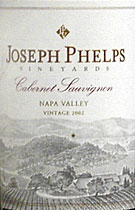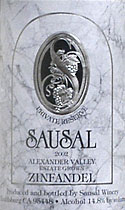|
This article was published in The 30 Second Wine Advisor on Monday, March 6, 2006.
Hugh Johnson: A Life Uncorked
And perhaps mostly because I encountered him first, before Robert M. Parker Jr. or Wine Spectator had even appeared on the wine world's radar, I feel a deep affection for Hugh Johnson, whose little pocket wine encyclopedia - it must have been the 1978 edition - was my first introduction to serious wine. As this prolific scribe added book after book to his collection, I read them as quickly as he turned them out, and it's no exaggeration to say that his approach and his style molded the way I think about wine.
There's something about the way the British writers in general approach the world of wine that fits comfortably with my impression of our favorite beverage as a civilized and inseparable part of life. Some of the American writers almost seem to feel that wine is a sort of hobby that can be learned from workbook or manual, reduced almost to a set of mathematical formulas, an thing that can be segregated from its surroundings and enjoyed without outside context.
A passage in Johnson's new biography, "A Life Uncorked," almost made me jump up from my chair with a shout, it expressed this distinction so well. Let's turn the pulpit over briefly to Hugh for this telling excerpt:
This kind of puts those 90-point Barossa Shirazes or overwhelming Spanish Priorats into a new context, doesn't it? Johnson goes on ...
So much for blockbuster wines bearing, in Parker's famous and parody-inviting phrase, "gobs of hedonistic fruit." And lest there be any doubt that he's consciously staking out separate ground, Johnson adds, a bit later in the book ...
As, in fact, do I. So naturally when Johnson's latest book arrived (published in Britain last year, it's now out in a U.S. edition from University of California Press), I devoured it. Lavishly illustrated with many of Johnson's own photos, it ranges from wine style to wine style ("Bubbly," "White," "Red" and "Sweet"), recalling the places he's seen and the friends he has made in a long lifetime in wine. It's an unusual book, certainly not a handbook or novice's guide but a warm and loving and very personal remembrance and diary of his life in wine.
It makes me smile, with much the same kind of enjoyment I might take from enjoying a glass of fine wine with an excellent meal. But it also leaves me with a tear because, although Johnson doesn't explicitly say so, this long look back has the tone of a valedictory and a farewell. He'll be 70 in 2009, and I for one don't want to see him leave us.
If you'd like to order "Hugh Johnson: A Life Uncorked" from Amazon.com, the following link offers it for $22.02, a 37 percent saving from the $34.95 list price. Orders placed using this exact link will return a small commission to WineLoversPage.com.
For many years, we've been partners and friends with the good folks at The California Wine Club, a firm that has consistently impressed me - and that I know has impressed literally thousands of you - with their commitment to excellence in their wines and their consumer service.
While you probably know California Wine Club best as a reliable source of quality, affordable wines from carefully chosen "mom and pop" California producers, plus select higher-end wines through its Signature Series, you may not have been aware of its Connoisseur's Series, a remarkable wine club limited to rare California beauties that typically garner 90-plus ratings from the major critics but that are almost impossible to find in stores or even winery mailing lists.
Recently, for the first time ever, membership in Connoisseur's Series has become available to WineLoversPage.com readers and our 30 Second Wine Advisor subscribers.
In the Jan. 23, 2006, Wine Advisor, I reviewed my first set of Connoisseur's Series wines and was metaphorically blown away by their quality: These are wines that underscore California's standing among world-class wine regions.
Below I report on three more recent arrivals that reinforce that reaction. You may be able to find these wines at retail, although their quality, high ratings and limited production can make them difficult to track down. But Connoisseurs' Series makes it easy, by doing the work of selecting and sourcing the wines for you, then offering the opportunity to buy additional bottles in half- or full-case lots at attractive discounts. If you're in the market for the very best California wines, I can't imagine a better way to get the maximum bang for your buck than through Connoisseur's Series.
The Connoisseur's Series is the only wine club in America that can guarantee a monthly wine shipment of impossible-to-find, 90-plus-rated wines - each and every time. Whether you choose to receive wines monthly, every other month or quarterly, every shipment is guaranteed to include two to four bottles of California's highest-rated wines, along with detailed tasting notes, cellaring recommendations and winemaker comments. Monthly shipments average $125-$175, including all shipping and handling.
To join this elite club, call The California Wine Club at 1-800-777-4443 and ask about The Connoisseur's Series. Feel free to tell them that I sent you ... and, if you join, please don't hesitate to contact me by E-mail and tell me what you think.
This wine shows an inky, deep color, black almost to the edge, where there's a thin rim of reddish-purple. Lovely aromas of black fruit and a hint of cocoa over distinct eucalyptus paint a classic Napa Cabernet profile, and it's just as well put-together on the palate, where full-bodied black cherries and plums are built on a sturdy structure of acidity and firm but palatable tannins. It's drinking beautifully now, especially with rare beef on the table, but it will surely reward extended cellar time. The addition of 8% Petit Verdot, 6% Merlot and 3% Cabernet Franc add a touch of Bordeaux-style complexity to the blend. Winery Website: http://www.jpvwines.com/index.html (Feb. 27, 2006)
Another inky blackish-purple, this Gold Rush Country Rhone Ranger is dark all the way to the edge. Deep and brooding, lovely Syrah fruit mingles black plums and leather - not saddle leather but well-bound antique books - with just a hint of menthol. Full and ripe, black fruit flavors are consistent with the nose, with a firm acidic backbone that shows a real kinship with the ageworthy Syrahs of the Northern Rhone. Soft tannins are well integrated, and it carries its substantial 14.5% alcohol well. It made a first-rate match with the earthy, spicy flavors of North African merguez lamb sausages over couscous. 800 cases made. Winery Website: http://www.terrerougewines.com (March 2, 2006)
Not merely inky but opaque, as black and shiny as patent leather, with a glint of purple at the edge. Ripe blackberries and judiciously handled oak come together in an appetizing blend of fresh berry scents and brandied fruit compote. Big and full-bodied, mouth-filling fruit and bright acidity, with full, round fruit flavors that suavely conceal its hulking 14.8% alcohol content. Italian-style hamburgers enhanced with porcini made a stylish complement. http://www.sausalwinery.com/ (March 5, 2006)
|


 Joseph Phelps 2002 Napa Valley Cabernet Sauvignon ($48 retail, $44 per bottle for half or full case orders from Connoisseurs' Series)
Joseph Phelps 2002 Napa Valley Cabernet Sauvignon ($48 retail, $44 per bottle for half or full case orders from Connoisseurs' Series)
 Terre Rouge 2002 Shenandoah Valley California Sentinel Oak Vineyard Pyramid Block Syrah ($44 retail, $39 per bottle for half or full case orders from Connoisseurs' Series)
Terre Rouge 2002 Shenandoah Valley California Sentinel Oak Vineyard Pyramid Block Syrah ($44 retail, $39 per bottle for half or full case orders from Connoisseurs' Series)
 Sausal 2002 Alexander Valley Private Reserve Zinfandel ($22 retail, $18 per bottle for half or full case orders from Connoisseurs' Series)
Sausal 2002 Alexander Valley Private Reserve Zinfandel ($22 retail, $18 per bottle for half or full case orders from Connoisseurs' Series)